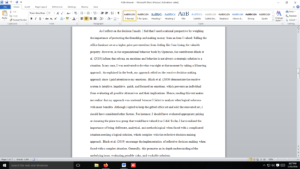Cognitive Bias in Decision-Making
We like to think that decisions should be, and are, made using a rational process. As described in Chapter Six, issues are defined, alternatives are generated, criteria for evaluating these alternatives are developed, and the alternatives are evaluated against these criteria. Pros and cons of each alternative are generated and considered. In human resource management, the process that should be used when evaluating candidates for a job is described in this fashion. (See Table 17.2)
In reality, many decisions are made in much less rational manner. Chapter Six describes some biases in decision-making, and people often use heuristics to try and narrow down choices. The chapter provides many examples of challenges in making decisions, including a table with some logical fallacies. (A “less than scientific” list of many potential biases and fallacies is available in Wikipedia ( https://en.wikipedia.org/
For this paper, focus on one “significant” decision you have made in your life. It could be regarding a job, where to attend college, what major to study, who to marry (or not), or involve a major purchase. Look back on that decision and reflect on how rationally, or irrationally, the decision was made. Identify the biases and heuristics that may have influenced the decision, and describe their impact. Finally, describe whether you believe the final decision, however flawed the process, was a good one or not.
Requirements: 
Answer preview
As I reflect on the decision I made, I feel that I used a rational perspective by weighing the importance of protecting the friendship and making money from an item I valued. Selling the office furniture set at a higher price prevented me from feeling like I am losing the valuable property. However, in the organizational behavior book by Openstax, the contributors Black et al. (2019) inform that relying on emotions and behavior is not always a strategic solution to a situation. In my case, I was motivated to do what was right at that moment by taking a lifesaving approach. As explained in the book, my approach relied on the reactive decision-making approach since I paid attention to my emotions. Black et al. (2019) demonstrate the reactive system is intuitive, impulsive, quick, and focused on emotions, which prevents an individual from evaluating all possible alternatives and their implications. Hence, reading this text makes me realize that my approach was irrational because I failed to analyze other logical solutions with more benefits. Although I opted to keep the gifted office set and sold the renovated set, I should have considered other factors.
[1484 Words]
Cognitive Bias in Decision-Making


